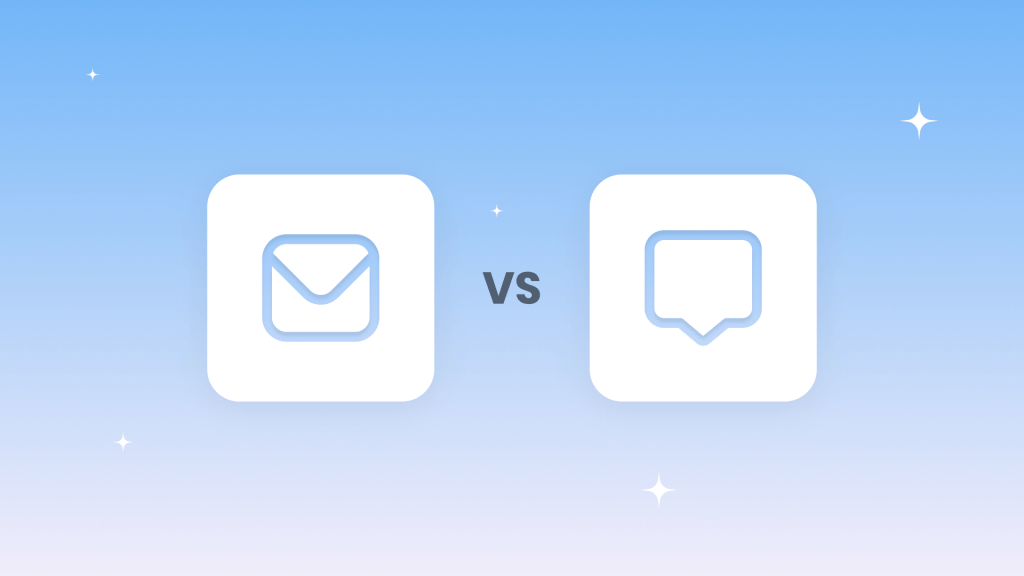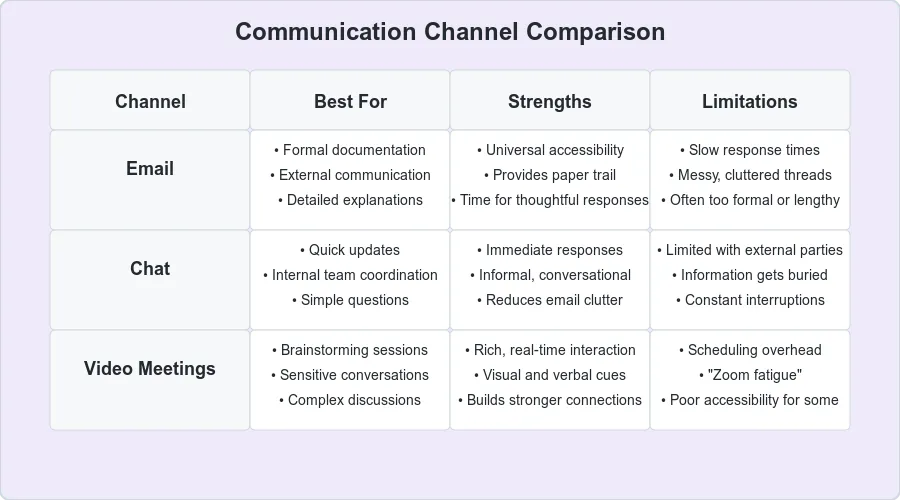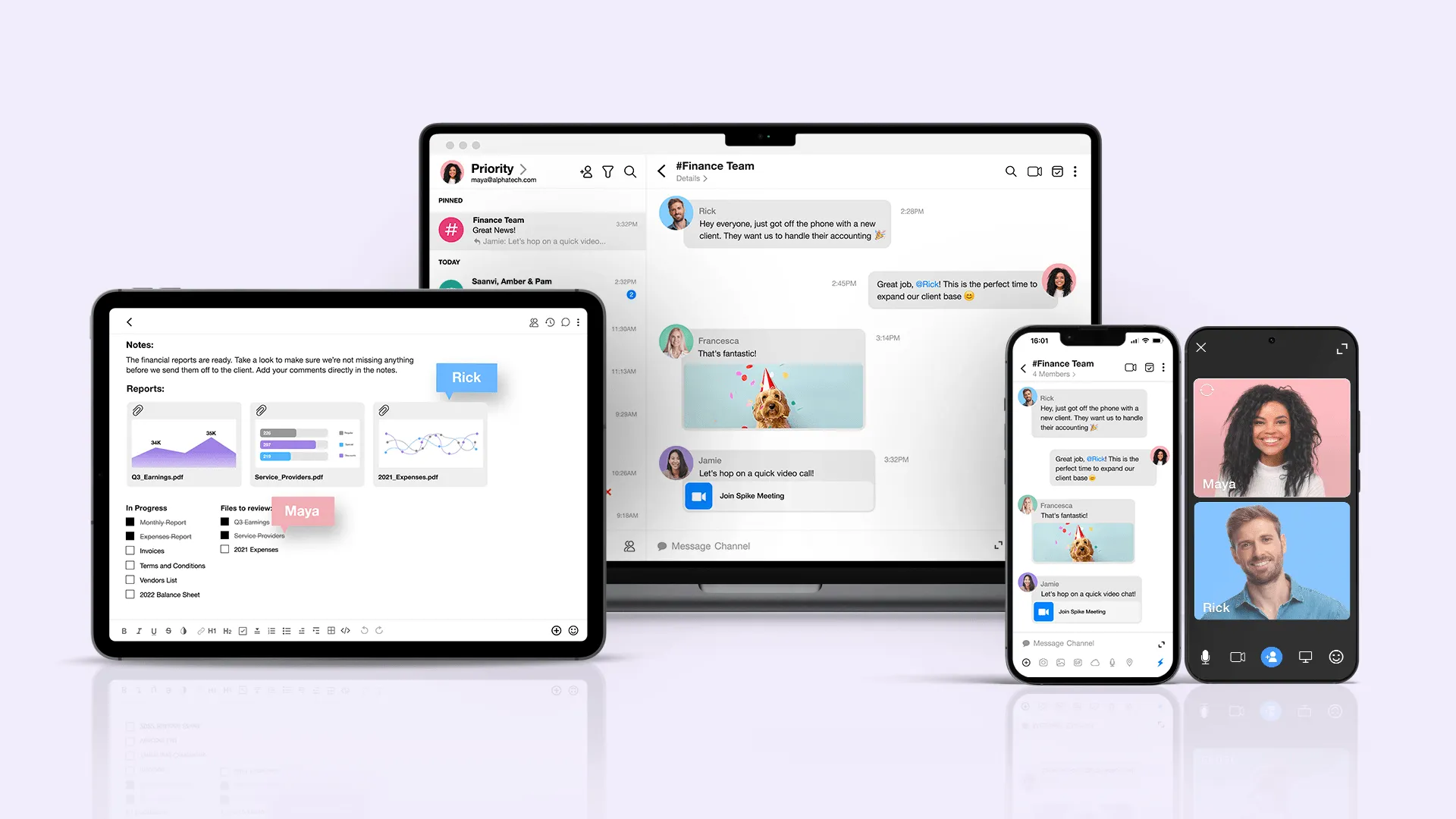Email vs. Chat vs. Meetings: A Thoughtful Guide to Workplace Communication

You need to send a message.
Should it be an email?
A quick chat?
Maybe a meeting?
If you get it wrong, you risk delays, confusion, or wasted time. Email can feel too formal, chat too fleeting, and meetings can take over your entire day.
The irony is that we have too many ways to communicate, yet somehow, we struggle to convey the message. We default to whatever seems easiest, but that’s not always the best choice. Ever since video calls became effortless, more and more discussions that could have been handled in writing are now meetings, but does that actually improve collaboration?
This guide focuses on communicating effectively when you’re not face-to-face, whether working remotely, coordinating across teams, or simply avoiding unnecessary meetings. It breaks down when to use email, chat, or meetings with real insight into how each method shapes communication, culture, and efficiency. By the end, you’ll know exactly which tool to use.
You’ll learn:
- Why choosing the wrong communication method creates friction, delays, and unnecessary meetings.
- How email, chat, and meetings affect tone, speed, and clarity differently.
- Why modern workplaces over-rely on video calls and when written communication is actually better.
- How to make smarter choices so your team stays aligned without wasting time.
Let’s get into it.
The Workplace Communication Dilemma
In language, we adapt our tone and style depending on who we speak to. The same applies to workplace communication. We “switch” between email, chat, and meetings based on formality, urgency, and who’s involved. But these choices aren’t always intentional. Often, we default to what feels easiest at the moment.
Remote work has made video calls the default for everything, with many teams assuming face-to-face time is always more efficient. But Zoom fatigue and scattered chat conversations tell a different story. The real challenge isn’t just picking a tool; it’s knowing when and why to use each one.
What Are Our Options?
When we’re not face-to-face, workplace communication happens through three primary channels:
- Email: Structured, asynchronous, and widely accepted.
- Chat: Fast, informal, and team-centric.
- Video meetings: Interactive, real-time, and best for complex discussions.
Each serves a different purpose, but using them incorrectly can lead to wasted time, confusion, or misalignment. Here’s a clearer breakdown of when and why to use each one.
1. Email: Structure, documentation, and external communication
Email remains the universal standard for professional communication, especially for external stakeholders. It’s ideal for:
- Formal communication: Client proposals, contracts, and policy updates.
- Asynchronous collaboration: Allowing recipients to read and respond on their own schedule.
- Record-keeping: Easily searchable for key decisions and agreements.
However, email can be slow, overly formal, and hard to manage when conversations stretch into endless threads.
2. Chat: Speed, collaboration, and team alignment
Chat tools like Slack and Teams have redefined internal communication by enabling instant, informal conversations. It’s best for:
- Quick updates: Simple questions, confirmations, or casual check-ins.
- Collaborating in real-time: Keeping internal teams aligned throughout the day.
- Reducing inbox clutter: Avoiding long email chains for minor topics.
Despite the benefits, chat can be distracting, overwhelming, and difficult to track if too many messages flood different channels.
3. Video meetings: Real-time connection and deep discussions
Video calls attempt to replicate in-person interaction, making them valuable when nuance, brainstorming, or relationship-building is needed. They’re most useful for:
- Brainstorming and creative discussions: Where back-and-forth idea sharing is key.
- Sensitive or complex topics: Performance reviews or conflict resolution.
- Team bonding: Reinforcing culture and engagement in remote teams.
However, video meetings are overused, often replacing what could have been an email or chat. Too many calls reduce focus time and contribute to Zoom fatigue.
The Bottom Line
Choosing between email, chat, or meetings isn’t about labeling one “best” but recognizing when each channel shines. Use them carelessly, and you’ll see friction, misunderstandings, and wasted time.
But use them strategically, and you’ll streamline collaboration and free your team to focus on real work.

Choosing the Right Communication Channel
When to Use Email, Chat, or Meetings
1. Quick updates or simple questions
- Message type: A brief check-in, confirmation, or FYI.
- Audience: Teammates or direct reports who are usually online.
- Desired outcome: Fast, informal response.
Best fit: Chat
Chat is instant, perfecting for quick yes/no or requests like “Which file do I need?” It allows for back-and-forth follow-ups without the formality of email.
However, chat can be disruptive if overused, and essential info can get buried in active channels. Use it quickly when you need a response, but not when details must be referenced later.
2. Detailed explanations or decisions
- Message type: Complex instructions, policy changes, or decisions requiring a record.
- Audience: Your team, stakeholders who need a reference, or someone who needs time to digest details.
- Desired outcome: Clarity, consensus, and a paper trail.
Best fit: Email
Email forces you to organize your thoughts and provides a written record. Recipients can re-read details, respond thoughtfully, and forward them to relevant parties. It’s ideal for structured communication without getting lost in a chat thread.
However, emails can easily become too long or formal. Keep them concise, scannable, and well-structured with bullet points and clear action items.
3. External communication and official updates
- Message type: Client proposals, formal documentation, partnership outreach, or company-wide memos.
- Audience: External clients, vendors, or an entire organization.
- Desired outcome: Professional impression and a reliable record.
Best fit: Email
Email is universally recognized as the standard for external communication. Attachments, signatures, and timestamps provide legitimacy; recipients expect email for formal exchanges.
Note that excessive formality can create distance. Keep it professional but readable, and ensure consistency in branding and tone.
4. Brainstorming and open-ended discussions
- Message type: Collaborative idea generation, problem-solving, or creative work.
- Audience: Small groups where multiple perspectives are needed.
- Desired outcome: Fast-paced iteration, relationship building, or creative energy.
Best fit: Video meeting
Real-time discussion allows for immediate feedback, dynamic problem-solving, and a stronger team connection. Seeing people’s reactions can help ideas evolve quickly.
A word of caution: meetings can spiral into tangents and waste time. Keep them focused, limit the invite list, and document takeaways immediately.
5. Sensitive or complex topics
- Message type: Performance reviews, conflict resolution, or major decisions affecting careers.
- Audience: Specific individuals who need personal interaction.
- Desired outcome: Clarity, emotional intelligence, and trust.
Best fit: Video meeting
The tone is easily misinterpreted in writing. A live conversation allows for nuance, immediate clarifications, and human connection. Face-to-face meetings are particularly important when emotions or major decisions are involved.
However, private issues should not be escalated into group meetings. Ensure the setting is appropriate for open, honest discussion.
6. Urgent crises or time-sensitive updates
- Message type: Security alerts, last-minute changes, or immediate blockers for a project.
- Audience: Anyone directly impacted, including managers or executives.
- Desired outcome: Quick resolution or immediate awareness.
Best fit: Chat
Chat grabs attention faster than email; a quick call ensures alignment on urgent matters. For high-stakes issues, real-time communication prevents delays and misinterpretation.
Remember not to skip a written follow-up. Even after a quick chat or call, summarize key points and next steps in writing.
How Spike Brings the Best of All Worlds Together

Each channel has clear strengths and weaknesses. What if a single platform allowed you to pivot between them without friction?
Spike combines email structure with the speed of chat, eliminating messy threads and formality when they’re unnecessary. Need real-time discussion? Jump to voice or video without leaving the conversation.
By blending email’s universality, chat’s agility, and built-in calls, Spike streamlines communication so teams can collaborate without switching between apps or scheduling unnecessary meetings.
Key features:
- Chat-like email: Eliminates cluttered threads and keeps conversations fluid.
- Built-in voice and video calls: Switch to real-time discussion instantly.
- AI-powered assistance: Smart replies, automated summaries, and inbox organization.
- Universal email compatibility: Works with any email address; no new platform required.
- Collaborative notes and tasks: Keep work aligned without switching apps.
Spike removes friction from communication, making it easier to work smarter.
Rethinking Workplace Communication
Choosing the right communication tool isn’t just about preference, it’s about productivity, clarity, and respect for time. Email, chat, and meetings each serve a purpose, but defaulting to the wrong one can create unnecessary friction.
Be intentional. Use chat for speed, email for clarity, and meetings only when real-time discussion is truly needed. Don’t let habit dictate your choices. Match the tool to the situation.




